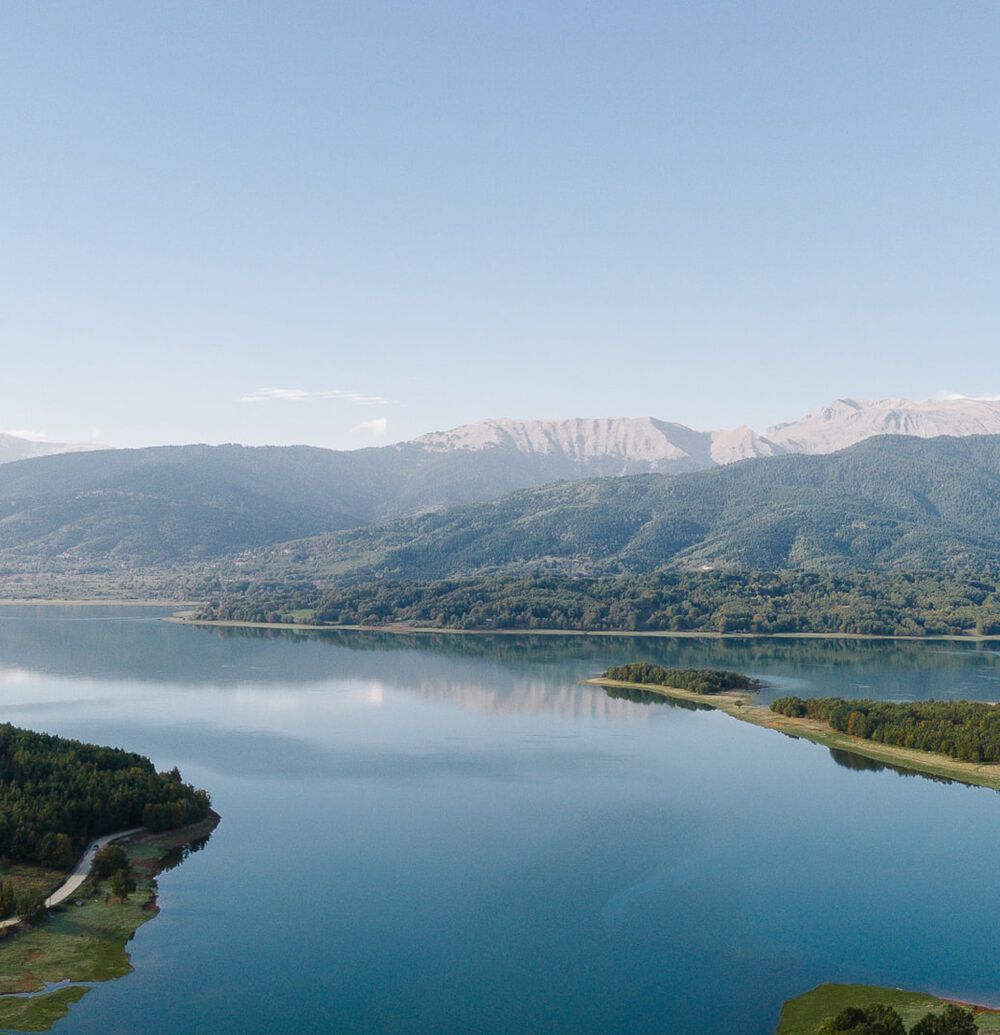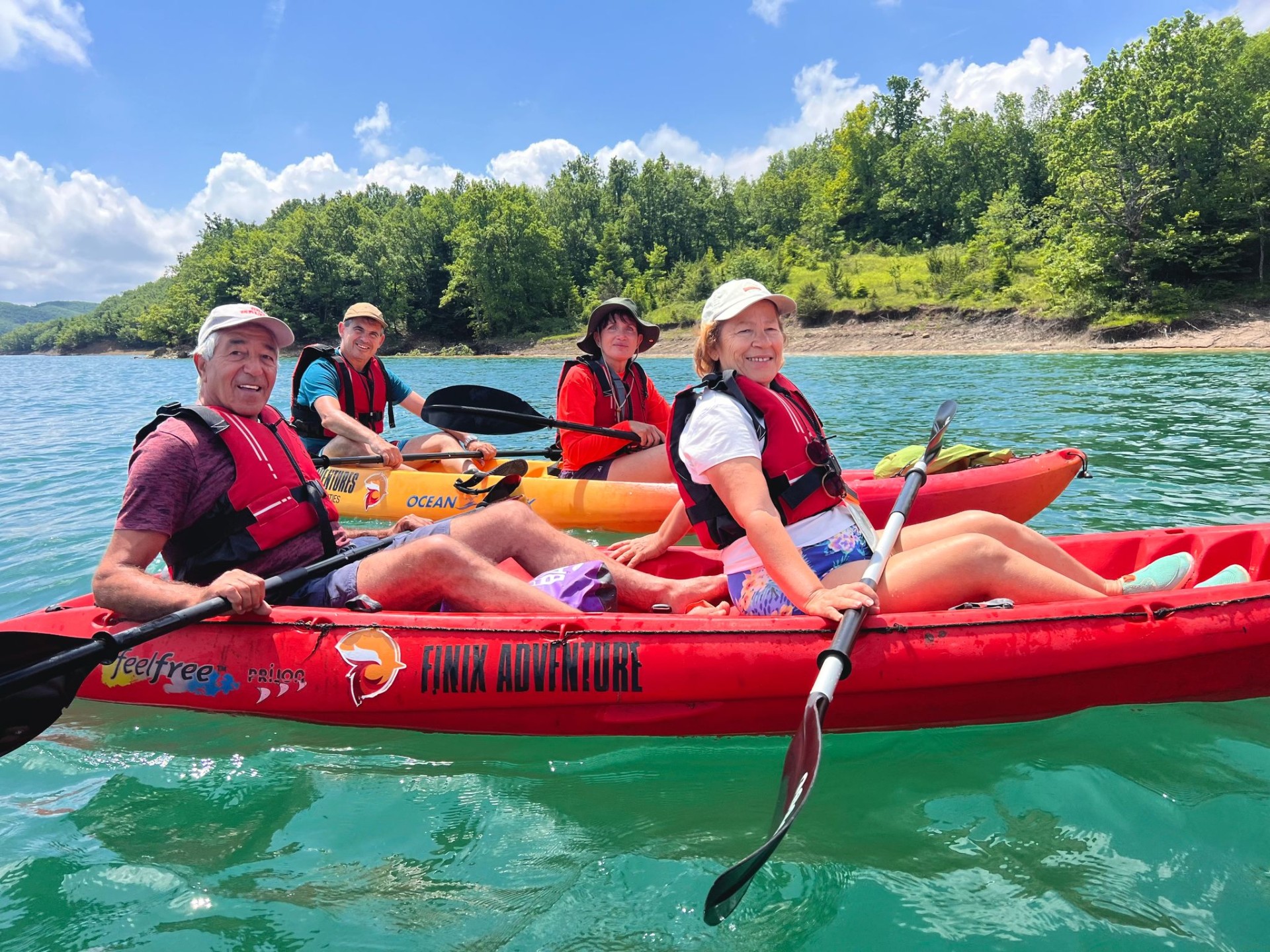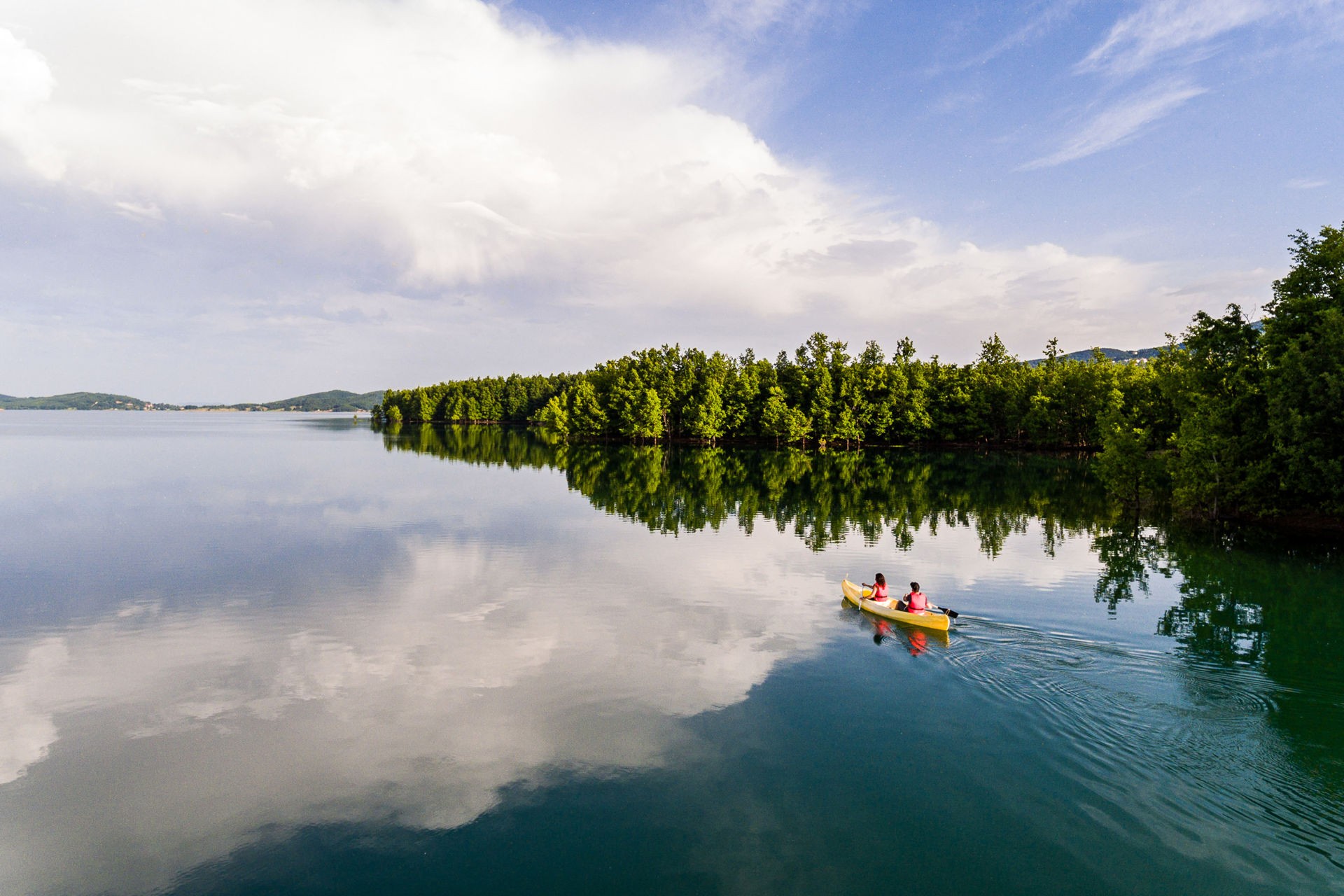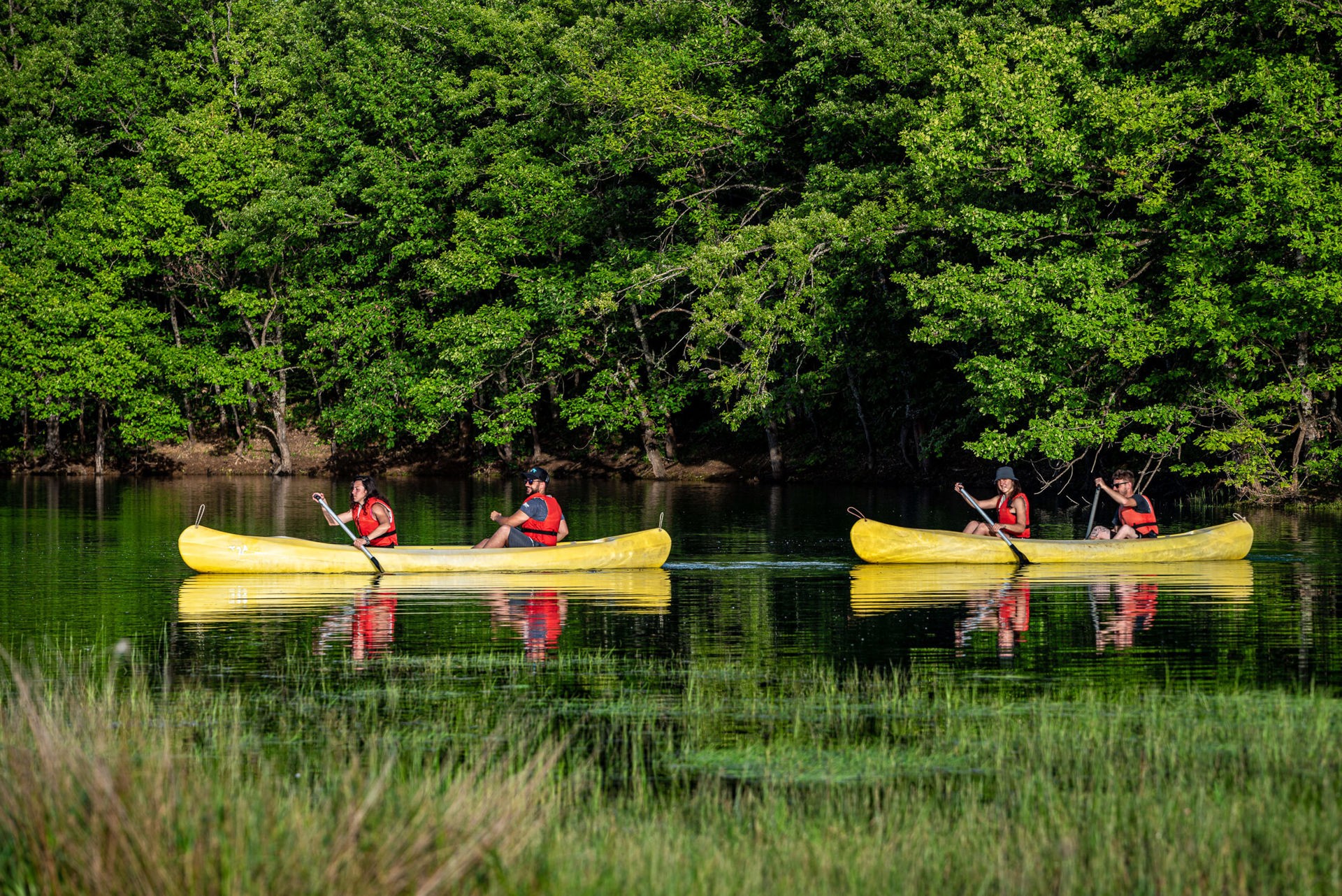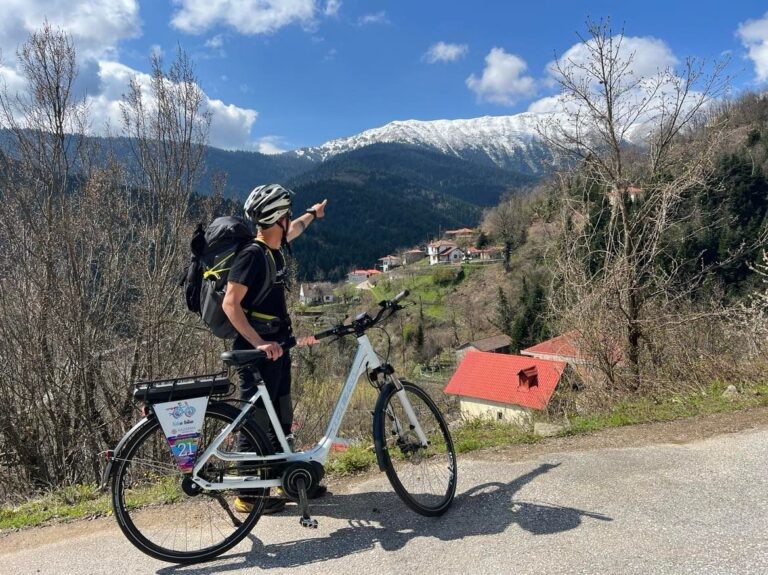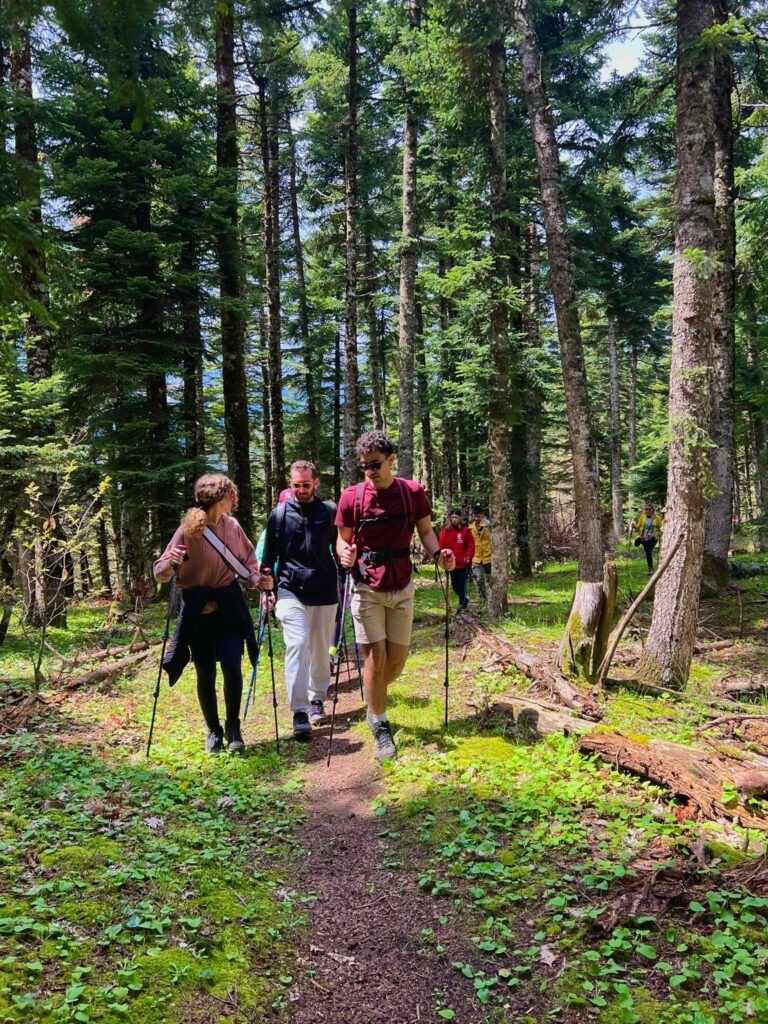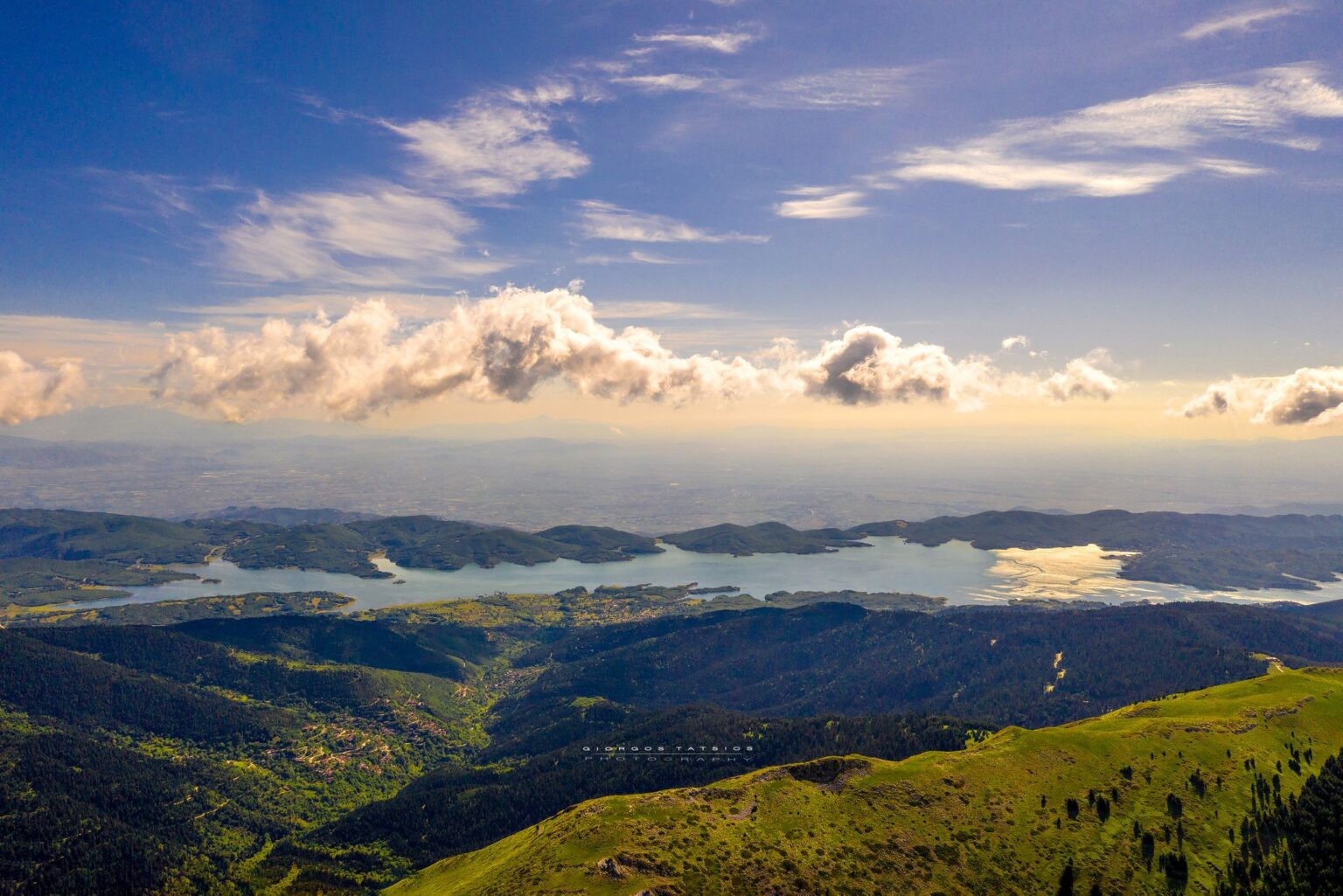Lake Plastira lies in the Thessaly region of mainland Greece, surrounded by the forested slopes of the Agrafa mountains. Created by damming the Tavropos River at an altitude of 700m, it was designed to irrigate the Karditsa plain in the heart of the country, supply water and generate electricity – but has also become a year-round destination for nature lovers and outdoor enthusiasts. Whatever your interests, there are plenty of things to do around Lake Plastira – from enjoying lakeside activities and hikes to discovering the local food and wine.
Lake Plastira in central Greece offers activities year-round, including kayaking, canoeing, cycling, hiking, and wine tasting at local organic vineyards. Surrounding villages like Neraida, Belokomiti, and Morfovouni each add unique cultural, historical, and scenic experiences—like trails, stone houses, museums, and spectacular views. The lake’s tranquil coves and birdlife invite exploration by boat, while Finix Adventures provides guided outdoor experiences, helping visitors discover the best of both the lake and Agrafa mountains.
Lake Plastira in central Greece offers activities year-round, including kayaking, canoeing, cycling, hiking, and wine tasting at local organic vineyards. Surrounding villages like Neraida, Belokomiti, and Morfovouni each add unique cultural, historical, and scenic experiences—like trails, stone houses, museums, and spectacular views. The lake’s tranquil coves and birdlife invite exploration by boat, while Finix Adventures provides guided outdoor experiences, helping visitors discover the best of both the lake and Agrafa mountains.
Explore the villages around the lake
Neochori
One of the great joys of visiting Lake Plastira is discovering the villages around it, some visible, others tucked quietly among fir trees. They often have incredible lake views and come with cosy tavernas serving local specialities and traditional cafes. Some also have stone guesthouses with modern comforts. The largest villages near Lake Plastira are Neochori and Kalyvia, close to the western shore and with excellent places to stay and eat. In Neochori, the Botanical Garden is a beautiful space dedicated to the region’s endemic and medicinal plants. There are also shops with herbal teas, essential oils and natural cosmetics, and plenty of places to buy local produce.
Elsewhere, the villages are even quieter and more remote. Neraida is known for its pine-covered slopes and views all the way to Mount Olympus. It’s also the starting point for hikes to Alexandris Spring or Pezoula. Belokomitis is memorable for its stone houses and carved balconies, while Kryoneri, with its little chapel of Ai-Giorgis, offers lush scenery and fresh produce. Kerasia delivers sweeping views of the lake and nearby river, and Kastania is home to a traditional Footwear Workshop & Museum. Lampero is tiny and offers postcard-perfect panoramas, and Anthochori is a picturesque stop. Finally, Morfovouni, the birthplace of General Nikolaos Plastiras, adds historical depth. It was Plastiras who first envisioned the lake in 1928, and the village is home to a museum in his honour – a fitting tribute to the man whose dream transformed this mountain plateau into the "lake of four seasons".
Local Tip: The Plastira Lake Festival in Neochori is a three-day celebration of music, nature and creativity in July, with live concerts by top Greek artists and lakeside events.
Enjoy the activities on Lake Plastira
The next of our things to do is not around but on Lake Plastira. Activities include hiring sea bikes, canoes or kayaks, and even small electric boats. Exploring scenic coves and quiet corners of the lake is the perfect way to take in the natural surroundings and appreciate the birdlife. You can spot cormorants, herons, moorhens, sandpipers and various duck species, while wagtails and water blackbirds dart along the shoreline. Beneath the surface, the lake is rich in fish, including trout, carp and perch. Meanwhile, Niagas island, in the middle of the lake, is the perfect mid-journey stop for a peaceful picnic and swim.
Get closer to nature around Lake Plastira
Saloon Farma Zampeta
One look at the beautiful landscape and you’ll be itching to arrange some activities around Lake Plastira. If you have kids, you’ll love the Saloon Farma Zampeta, between Kryoneri and Morfovouni. It offers horse riding through fir trees and open meadows and archery, as well as other activities like mini-golf and climbing. It’s also where you can rent electric boats.
Another way to enjoy the countryside is to book a guided e-bike tour along the slopes of the Agrafa mountains. You pass traditional villages, stone bridges and watermills and can stop for a swim if you like. There are also plenty of hikeing trails to enjoy in the area, including the gentle trail from Neochori to Belokomitis, through oak and fir forests, rich in mushrooms and plant life.
Local tip: If you want to see the night sky as you’ve never seen it before, you can organise a stargazing session by the lake.
Drive to the Lake Plastira Viewpoints
Observatory of Plastiras Lake
There are various vantage points around the lake, but the best place to start is on the dam wall itself, at Kakavakia. The size of the engineering project speaks for itself. The dam wall is 83m tall, and the reservoir it created has a capacity of 400 million cubic metres of water. For the best views, however, the Lake Plastira Observatory is around 15 minutes away by car. From here, you can see how harmoniously the manmade lake fits in with the surrounding forests and mountains.
Another highlight is the Panagia Pelekiti Monastery, around 6km from the dam wall and one of the most remarkable cultural landmarks around Lake Plastira. Built into the rock at 1,400m altitude in the 16th century, it takes its name (Pelekiti means ‘hewn’) from the way it appears carved into the cliffside. After a short uphill walk, you’re rewarded with beautiful frescoes and breathtaking views of the lake and the Agrafa mountains.
Discover the wine culture of Lake Plastira
Monsieur Nicolas Winery
Next on your list of things to do around Lake Plastira is to explore the area’s proud wine-growing tradition. Thanks to the cool mountain climate, the conditions are ideal for cultivating grapes, including the rare red variety Black Messenikolas, grown in just three villages in Greece. A standout stop is the village of Messenikolas, where the Monsieur Nicolas Winery has been run by the Karamitros family for four generations. Set at 700m altitude, the vineyard benefits from Lake Plastira’s unique microclimate. You can enjoy a tasting of local wines, including the PDO Messenikola blend, and a tour of the cellars to learn how centuries-old tradition meets modern winemaking. Just a few steps away, the Messenikolas House of Wine and Vine is dedicated to the tools, techniques and stories of local wine production.
Expanding your wine experience further, head to Kontozisis Organic Vineyards near Kanalia, pioneers of natural winemaking in the region. Since 1991, they’ve focused on organic methods and indigenous grapes like Limniona, Malagousia and Assyrtiko, offering tastings that highlight the purity of their winemaking techniques.
Local tip: Every August, Messenikolas hosts a wine festival, where locals share their celebrated wines with visitors from all over Greece.
Experience the local tastes
Koronis Monastery
With such a fertile landscape and long-held food traditions, the area around Lake Plastira treats visitors to a rich culinary experience. Hearty mountain dishes like boiled nanny goat, pork knuckle (kotsi) and sausages with leeks are favourites, while pies such as plastos (cornmeal with greens), batzina (crustless courgette and feta pie), and bobota (corn bread) reflect the region’s agricultural roots.
For a local treat, head to Voyatzis taverna in Karditsa for dishes like kavourmas (a kind of duck confit), lamb with spinach, and oxtail with orzo. Other mountain favourites include mushroom soups and wild boar meatballs. Local dairy products include PDO Agrafon feta and the creamy, tangy tsalafouti cheese. Shops and bakeries stock everything from handmade trachanas (fermented grain) to spoon sweets and herbal blends.
And for a very special experience, visit the Koronis Monastery, perched on a hill with sweeping views of the lake. It’s one of the oldest monastic sites in the region, dating back to the 12th century, and is home to a small community of nuns. You’ll find local honey, dried herbs, handmade soaps and other products for sale.
Local tip: Every year, around Easter, Neochori village holds a Mushroom Festival, where there is also a mushroom park with wooden sculptures at the Neochori Environmental Centre. At other times, pop into Artemis café in Neochori and ask for Giorgos Karantonis. He can tell you all about local species and mushroom-related experiences.
Enjoy nearby escapes
Meteora
Lake Plastira makes an ideal base for discovering the wider region of western Thessaly. You’re just 20–30 minutes away from Karditsa, a relaxed city with tree-lined squares, pedestrian streets and cultural highlights including an Archaeological Museum and Folklore & History Museum. Further north, Trikala (around 1 hour) is a bicycle-friendly city in which you can explore the medieval Varousi quarter and stroll along the Litheos River. Sites in Trikala include the ancient Asclepius Sanctuary and the city’s Digital Museum.
For mountain escapes, follow the scenic route from Pyli to Elati and Pertouli (1hr 30mins) through fir forests and picturesque stone villages. Or head to Meteora, the UNESCO-listed wonder where centuries-old monasteries perch on towering rock formations – perfect for hiking or simply soaking in the majesty. Finally, if it’s wild nature you’re after, venture deeper into Argithea in the Agrafa mountains, with villages like Leontito, Palaiochori and the lakeside setting of Stefaniada, where kayaking, horse riding and archery await. Meanwhile, in Petrilo, a forested hideaway 1hr 45mins from Lake Plastira, you’ll find even more reasons to extend your stay.
After Best of Title
Things to do around Lake Plastira
Whatever the season, Lake Plastira rewards you with nature, authenticity and a peaceful rhythm that will stay with you. It’s the perfect place to slow down, reconnect with nature and explore at your own pace.
FAQs Title
More local tips about lake Plastira
- Lake Plastira dam – Along the road by the dam (especially on weekends), small wooden kiosks sell herbs and handmade products, often offering rakomelo (raki with honey and local herbs) as a welcome treat.
- Neochori shops – A great place to pick up cheese, honey, spoon sweets, preserves, pasta and herbal teas, with a range of local specialities ideal for gifts or souvenirs.
- Artemis Café (Neochori) – Famous for its 11 seasonal ‘spoon sweets’, including a standout grape variety, and a unique vodka mushroom liqueur.
- Hatzopoulos Bakery (Kalyvia) – The area’s oldest and best-known bakery, offering handmade pies, trachanas, tomato sauces, jams and local pasta.
- Montanema Handmade Village – Around 4.5km from the lake, an eco-retreat producing its own cheese, eggs, herbal teas, soaps, creams and bubble baths, all made from local or homegrown ingredients.
Hiking is a magical way to enjoy the Greek countryside but make sure to be prepared and protect yourself, especially on very hot days.
- Stay hydrated: Always wear a hat and carry plenty of water with you.
- Be weather-wise: Check the forecast before setting out. Avoid the midday heat and extremely hot periods. The best times for hiking around Lake Plastira are spring (April-May) and autumn (late September-October). It is also best to avoid winter on Mount Ainos and other elevated hikes.
- Plan your walk: Whenever possible, follow marked trails and plan your walk. Ideally, use a guide and never hike alone. Ask for directions, if you’re unsure. This helps protect both you and the natural environment.
- Stay connected: Have the phone numbers of your hotel and local authorities handy. And make sure your mobile phone is fully charged. The European emergency number 112 is available 24/7, connecting you to local police, fire and ambulance services.
